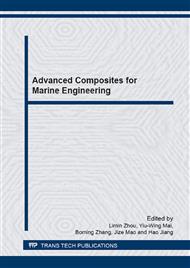p.210
p.220
p.243
p.250
p.258
p.265
p.273
p.278
p.285
Preparation and Characterization of In Situ Polymerized Cyclic Butylene Terephthalate and its Composites
Abstract:
A fatal disadvantage of continuously reinforced thermoplastic composites is the high melt viscosity of the matrix which hampers impregnation. However, the melt viscosity of low molecular weight CBT resin can reach extremely low value, which simplifies impregnation and enables the use of thermoset production methods. The thermal analysis, rheological analysis and mechanical property on the polymerization and crystallization of CBT into poly (cyclic butylene terephthalate) (PCBT) at different ratios of catalyst were investigated in this paper. The continuous glass fiber (GF) reinforced PCBT composite with over 70% fiber volume content was prepared via in situ polymerization, and the mechanical property of the PCBT was studied. The best impregnation time was decreased and the degree of crystallinity was increased respectively with catalyst fraction increasing. The tensile/flexural strength and modulus of PCBT resin and GF/PCBT composites were enhanced when the catalyst fraction increased from 0.3% to 0.6%.
Info:
Periodical:
Pages:
258-264
Citation:
Online since:
March 2015
Authors:
Price:
Сopyright:
© 2015 Trans Tech Publications Ltd. All Rights Reserved
Share:
Citation:


